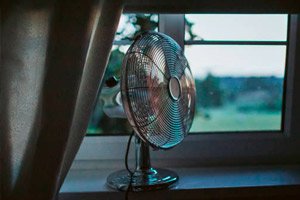
All iLive content is medically reviewed or fact checked to ensure as much factual accuracy as possible.
We have strict sourcing guidelines and only link to reputable media sites, academic research institutions and, whenever possible, medically peer reviewed studies. Note that the numbers in parentheses ([1], [2], etc.) are clickable links to these studies.
If you feel that any of our content is inaccurate, out-of-date, or otherwise questionable, please select it and press Ctrl + Enter.
In dry and hot conditions, a fan can increase body temperature in older people
Last reviewed: 03.08.2025

A study led by the Montreal Heart Institute found that older adults using an electric fan at 38°C and 60% relative humidity experienced a slight decrease in body temperature and a greater feeling of comfort. Using a fan at 45°C and 15% relative humidity increased body temperature and increased discomfort.
CDC guidelines warn against using fans in temperatures above 90°F (32°C) due to concerns that the extra airflow could accelerate body heating in vulnerable groups. Modeling studies and small lab tests have suggested that airflow may help in high humidity, but the effects in very hot temperatures in older adults remain unclear. Older adults are at increased risk for heat-related illness, creating a pressing need for practical, low-cost cooling methods.
In the study, “Thermal and perceptual responses to fan use in extreme heat in older adults,” published in JAMA Network Open, researchers conducted a secondary analysis of a randomized, crossover clinical trial to test how fan use and skin humidification affect body temperature, sweating, and thermal sensations during extreme heat exposures.
A cohort of 58 community-dwelling older adults (68 ± 7 years), including 27 with coronary artery disease, completed 320 laboratory sessions in a climate chamber. Each participant spent three hours at 38°C and 60% relative humidity or 45°C and 15% relative humidity.
The wet trial included four randomized conditions: control, fan only, skin humidification only, and fan plus skin humidification, with at least 72 hours between sessions.
In a dry test at 45°C and 15% humidity, participants with coronary heart disease underwent only control sessions and sessions with skin moisturizing. Rectal temperature, sweating as a difference in body weight before and after the session, thermal sensations on a seven-point scale, and comfort on a four-point scale were measured.
In the humid chamber, fan use reduced rectal temperature by 0.1°C, increased sweating by 57 ml/h, and improved thermal sensation by 0.6 ASHRAE units and comfort by 0.6 units. Skin humidification reduced sweating by 67 ml/h and improved perception, and the combination of fan and humidification produced the greatest effect: thermal sensation -1.1 units, comfort -0.7 units, without changing body temperature.
In the dry chamber, fan use increased body temperature by 0.3°C, increased sweating by 270 ml/h, and decreased thermal sensation and comfort by 0.5 units each. Skin moisturizing decreased sweating by 121 ml/h and improved thermal sensation by 0.4 units, without affecting comfort.
The study authors conclude that electric fans may be a safe and inexpensive way to cool older adults in hot and humid weather at 100.4°F (38°C), but should be avoided in very hot and dry conditions. Simply moisturizing the skin provides an additional method of managing heat stress without the risk of dehydration. Health departments may use these results to adjust heat safety recommendations for older adults.
